End of Year Tax Model [U06]
- Propose Depreciation Methods [U0601]
- Submit Batch Job for Proposal [U0602]
- Gross Bookings by Quarter [U0603]
- Depreciation EOY [U0604]
- Gain/Loss EOY [U0606]
- Gross Profit Re-Calculation [U0607]
- Gross Profit Deferral [U0608]
Introduction

The End of Year Tax Model is a group of seven related functions used to generate proposals showing the effects of using different depreciation methods for assets placed in service in the current fiscal year on a portion of or all leases in a portfolio. These functions can be accessed from the LeasePak main menu through the Updates menu, End of Tax Year Model option, or by entering the individual function menu number into the Fast Menu <F2>.
Proposals made through the End of Year Tax Model may be run without changing the data files, so the most favorable methods for tax purposes may be explored.
Proposals are generated by first entering a desired depreciation method(s) in the Propose Depreciation Method update [U0601], then running the associated tax reports (Depreciation EOY [U0604] and Gain/Loss EOY [U0606]) to see the effects of method(s) entered.
The Gross Bookings by Quarter report [U0603] may be generated to see the percentage of gross bookings for each fiscal quarter, which has a bearing on whether MACRS Mid-quarter Convention depreciation method must be used.
If the decision is made to change depreciation calculation methods, files may be changed using the Submit Batch Job for Proposal [U0602] update. New year-end tax reports may then be produced which reflect the changes.
The End of Year Tax Model [U06] may be run any time after the End of Year process [U0401] is run and before the tax reporting deadline for year end for the portfolio. To determine the tax reporting deadline, refer to the TAX REPORTING DEADLINE parameter on the DEFERRAL, YEAR END screen of the Miscellaneous Customizations option of the Portfolio update [U0212].
Propose Depreciation Methods [U0601]
The Propose Depreciation Methods update [U0601] is used to propose changes to depreciation methods for selected assets on the Year-end Tax (RYR) file. Only assets that have not yet been reported (i.e., assets placed in service during the previous fiscal year) may have their depreciation methods changed.
After the desired changes to depreciation method have been entered through this update, year end tax reports may be produced to model what would happen if depreciation were actually changed. The Propose Depreciation Methods update [U0601] makes no changes to the data base. The depreciation methods entered are simply stored and used by the tax proposal reports in the End of Year Tax Model section. These are the only reports which use the methods entered in this update. Reports in the Controller's Tax report section will not access the proposed methods.
Actual changes to the database are implemented through the Submit Batch Job for Proposal update [U0602].
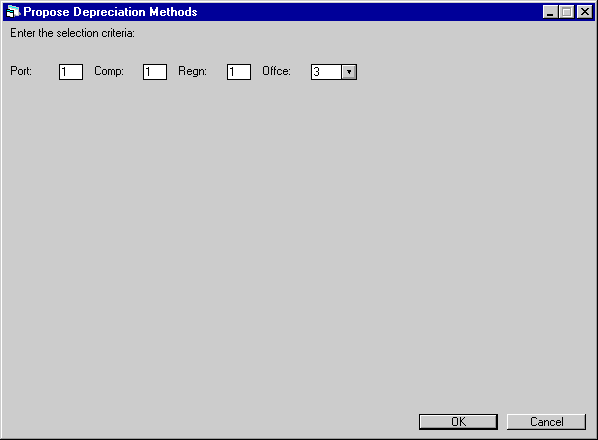
This screen is used to select the year-end lease portfolio or portion of the year-end lease portfolio whose depreciation methods should be changed. Only assets placed in-service during the previous fiscal year may have their depreciation methods changed.
For example, if the current date is August 1, 1995, the fiscal year-end is December 31, and the tax reporting deadline is September 30, the depreciation methods for any assets placed in-service in 1995 may be changed. If the current date is between the tax reporting deadline (9/30) and up to and including the fiscal year-end date (12/31), the End of Year Tax Model may not be run.
Refer to the Miscellaneous Customizations option of the Portfolio update [U0212] for the FISCAL YEAR END and TAX REPORTING DEADLINE parameters.
Field Descriptions
- PORT
Enter the portfolio number for leases to be selected.
- COMP
Enter the company number for leases to be selected. Leave COMP blank if all companies, regions and offices for a specific portfolio are desired.
- REGN
Enter the region number for leases to be selected. Leave REGN blank if all regions and offices for a specific portfolio and company are desired.
- OFFIC
Enter the office number for leases to be selected. Leave OFFIC blank if all offices for a specific portfolio, company and region are desired.
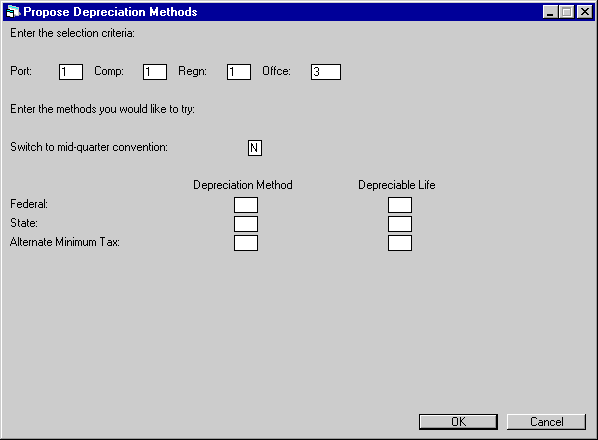
This screen is used to indicate methods and depreciable life to be used to calculate depreciation in the proposals. No file changes are executed until the Submit Batch Job for Proposal update [U0602] is run.
The depreciation methods entered here are stored only for the current End of Year Tax Model run. They are not saved if the End of Year Tax Model update section [U06] is exited.
- Switch
to mid quarter convention
This field defaults to N. Enter Y if the MACRS Mid-quarter Convention depreciation method for federal tax purposes is to be used.
If Y is entered, the FEDERAL DEPRECIATION and ALTERNATE MINIMUM TAX DEPRECIATION fields on this screen may not be accessed. Refer to the Gross Bookings by Quarter report [U0603] to determine whether the mid quarter convention must be used.
- FEDERAL DEPRECIATION
METHOD
Enter the first 2 letters of the 4-letter code for the federal depreciation method. The last 2 digits denote the depreciable life of the asset and are entered in the next field. Use Help for a list of valid federal depreciation method codes.
Leave FEDERAL DEPRECIATION METHOD blank if no changes should be made to federal depreciation codes. If FEDERAL DEPRECIATION METHOD is left blank, FEDERAL DEPRECIABLE LIFE may not be accessed.
FEDERAL DEPRECIATION may not be accessed if Y is entered in the SWITCH TO MID QUARTER CONVENTION field.
- FEDERAL
DEPRECIABLE LIFE
Enter the last 2 digits for the federal depreciation method selected in the previous field. These represent the depreciable life of the asset in years. The combination of depreciation method and depreciable life must be a valid federal depreciation method code. If this field is left blank or an invalid depreciable life category is entered, no changes in the federal depreciation method are calculated.
- STATE DEPRECIATION
METHOD
Enter the first 2 letters of the 4-letter code for state depreciation method. The last 2 digits denote the depreciable life of the asset and are entered in the next field. Use Help for a list of valid codes.
Leave STATE DEPRECIATION METHOD blank if no changes should be made to the state depreciation codes. If STATE DEPRECIATION METHOD is left blank, STATE DEPRECIABLE LIFE may not be accessed.
- STATE
DEPRECIABLE LIFE
Enter the last 2 digits for the state depreciation method selected in the previous field. These represent the depreciable life of the asset in years. The combination of depreciation method and depreciable life must be a valid state depreciation method code. If this field is left blank or an invalid depreciable life category is entered, no changes in the state depreciation method are calculated.
- ALTERNATE
MINIMUM TAX DEPRECIATION METHOD
Enter the first 2 letters of the 4-letter code for the alternate minimum tax depreciation method. The last 2 digits denote the depreciable life of the asset and are entered in the next field. Use Help for a list of valid codes.
Leave ALTERNATE MINIMUM TAX DEPRECIATION METHOD blank if no changes should be made to the alternate minimum tax depreciation codes. If ALTERNATE MINIMUM TAX DEPRECIATION METHOD is left blank, ALTERNATE MINIMUM TAX DEPRECIABLE LIFE may not be accessed.
ALTERNATE MINIMUM TAX DEPRECIATION may not be accessed if Y is entered in the SWITCH TO MID QUARTER CONVENTION field.
- ALTERNATE
MINIMUM TAX DEPRECIABLE LIFE
Enter the last 2 digits for the alternate minimum tax depreciation method selected in the previous field. These represent the depreciable life of the asset in years. The combination of depreciation method and depreciable life must be a valid alternate minimum tax depreciation method code. If this field is left blank or an invalid depreciable life category is entered, no changes in the alternate minimum tax depreciation method are calculated.
Submit Batch Job for Proposal [U0602]
The Submit Batch Job for Proposal update [U0602] is used when the decision has been made to change data files and reproduce the year-end tax reports. This update is used to modify depreciation codes for all selected assets on the Year-end Tax (RYR), Equipment (REQ), and Closed Asset (RCS) files.
Proposed method changes may be modeled through the Propose Depreciation Methods update [U0601]. Tax reports based on the proposed method changes may be run through the End of Year Tax Model to determine the effects of the proposed changes. If desirable, the Submit Batch Job for Proposal update [U0602] should be used to submit a batch (non-interactive) job which changes all applicable asset depreciation methods on file and recalculates depreciation based on the new methods.

This screen is used to verify that proposed methods for depreciation are correct. The update runs after the next End of Day processing [U0401]. If no method changes are selected through the Propose Depreciation Methods update [U0601], a message so indicating is displayed and no batch job is submitted.
- ACCOUNT
SELECTION
The portfolio or portion of the portfolio selected to be updated is displayed.
- MID
QUARTER CONVENTION
Y is displayed if the MACRS Mid Quarter Convention depreciation method for federal tax purposes is used; N if not.
- FEDERAL
DEPRECIATION METHOD
The new federal depreciation method, if any, is displayed. If Y is displayed in the MID QUARTER CONVENTION field, the new federal depreciation method is the MACRS Mid Quarter Convention method.
- FEDERAL
DEPRECIABLE LIFE
The depreciable life for the new federal depreciation method used is displayed.
- STATE DEPRECIATION
METHOD
The new state depreciation method, if any, is displayed.
- STATE
DEPRECIABLE LIFE
The depreciable life category for the new state depreciation method used is displayed.
- ALTERNATE
MINIMUM TAX DEPRECIATION METHOD
The new alternate minimum tax depreciation method, if any, is displayed.
- ALTERNATE MINIMUM
TAX DEPRECIABLE LIFE
The depreciable life category for the new alternate minimum tax depreciation method used is displayed.
- Do
you wish to continue (Y/N)?
Enter Y to submit the batch job when RETURN is pressed. The job changing depreciation methods will run after the next End of Day processing.
Gross Bookings by Quarter [U0603]
The Gross Bookings by Quarter report [U0603] is used to show the breakdown by fiscal quarter of the number and cost of assets placed in service during the fiscal year, and to determine the percentage of income booked in each fiscal quarter. It is created using the portfolio or portion of the portfolio entered in the first screen of the Proposed Depreciation Methods update [U0601]. If the Gross Bookings by Quarter report [U0603] is run without entering a selected portfolio in the first screen of the Proposed Depreciation Methods update [U0601], it reports on all portfolios if the Multi Portfolio Processing module is purchased, or on the default portfolio if not.
For assets placed in service after August 1, 1986, if 40% or more of income for the fiscal year is booked in the last fiscal quarter, then the MACRS Mid-quarter Convention depreciation method must be used.
The Gross Bookings by Quarter report [U0603] may be generated for the previous fiscal year or for the current fiscal year.
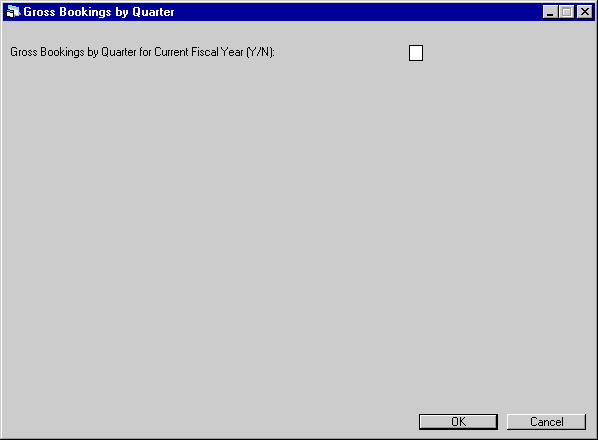
This screen is used to select the fiscal year for which the Gross Bookings by Quarter report is generated.
- GROSS
BOOKINGS BY QUARTER FOR CURRENT FISCAL YEAR (Y/ N)
Enter Y if the report is to be generated for the current fiscal year, N if it is to be generated for the previous fiscal year.
Gross Booking by Quarter Report

The Gross Bookings by Quarter report [U0603] is at the portfolio level and provides the following information for the last or current fiscal year:
- QUARTER
The number of the fiscal quarter (1st, 2nd, 3rd, 4th) is displayed.
- NUMBER
OF ASSETS BOOKED
The number of assets placed in service during the fiscal quarter is displayed.
- GROSS ORIGINAL
COST
The gross original cost (gross bookings) of the assets placed in service during the fiscal quarter is displayed.
- QUARTER
GROSS COST/YEAR GROSS COST
The percentage of the fiscal year's gross cost is displayed. This percentage is calculated by dividing the quarter's gross cost by the year's gross cost.
For example, if the year's gross bookings amounts to $1,143,223.00 and the quarter's gross bookings is $466,223.00, the percentage of gross bookings for the fiscal quarter is 40.78.
For assets placed in service after August 1, 1986, if 40% or more of income for the fiscal year is booked in the last fiscal quarter, then the MACRS Mid-quarter Convention depreciation method must be used.
If all portfolios are selected, a grand total page for all portfolios appears at the end of the report, assuming the Multi Portfolio Processing module is purchased.
Depreciation EOY [U0604]
The year-end tax Depreciation reports (federal and state) are re-created using the proposed federal and state depreciation methods entered in the Proposed Depreciation Methods update [U0601] for assets placed in service during the previous fiscal year.
If no proposed federal and/or state depreciation methods are entered in the Propose Depreciation Methods update [U0601], existing federal and/or state methods are used to recreate year-end tax Depreciation reports. For examples and description of the reports see the Tax Depreciation Report [R0304].
Gain/Loss EOY [U0606]
The year-end tax Gain/Loss reports (federal and state) are re-created using proposed federal and state depreciation methods entered in the Proposed Depreciation Methods update [U0601] for leases booked during the previous fiscal year.
If no proposed federal and/or state depreciation methods are entered in the Propose Depreciation Methods update [U0601], the existing federal and/or state methods are used to re-create the reports. For an example and description of the report, see the Tax Gain/Loss Report [R0311].
Gross Profit Recalculation [U0607]
The Gross Profit Recalculation update [U0607] is used to recalculate beginning gross profit and gross profit restored amounts. This update is only relevant if the user modified the cost or manufacturer's depreciation basis of asset(s) by means outside of LeasePak.
If the cost or manufacturer's depreciation basis of asset(s) have not been modified, executing this update will have no effect.
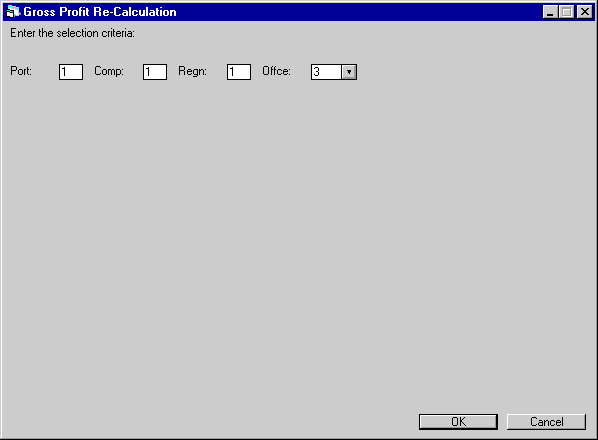
This screen is used to select the portfolio or portion of the portfolio as of year-end for which gross profit should be recalculated.
- PORT
Enter the portfolio number for the leases to be selected.
- COMP
Enter the company number for the leases to be selected. Leave COMP blank if all companies, regions and offices for a specific portfolio are desired.
- REGN
Enter the region number for the leases to be selected. Leave REGN blank if all regions and offices for a specific portfolio and company are desired.
- OFFIC
Enter the office number for the leases to be selected. Leave OFFIC blank if all offices for a specific portfolio, company and region are desired.
Gross Profit Deferral [U0608]
Gross profit deferral consists of 2 reports, Gross Profit Deferral [U0608A] and Tax Benefit Repayment [U0608B]. The Gross Profit Deferral report tracks the restoration of gross profit. In cases where tax benefit is transferred from a parent to a captive (e.g., in the form of an interest-free loan equal to the amount of the tax benefit), the Tax Benefit Repayment report [U0608B] tracks the current year repayment amount (from captive to parent) and the remaining balance to be repaid.
Only assets whose Tax Reporting parameter is set to Y are reported. Refer to the TAX RPTG field description in Add Asset [U0101] and Asset [U0210] updates or the TAX REPORTING field in the Application Asset tabs [U0801] for more information on this parameter.
Assets with an in-service date within a specific range can be selected. Therefore, the report may not show every asset for a multiple asset lease. If there is more than one active asset on the lease, totals are printed for the lease.
The report may be accessed through the End of Year Tax Model menu [U06] and may be selected interactively for:
- All assets
- A specific vendor

- PORT
Enter the portfolio on which to report.
- VENDR
Enter the number of the vendor on which to report. Leave blank if reporting across vendors. Use Help for a Client Search of vendors.
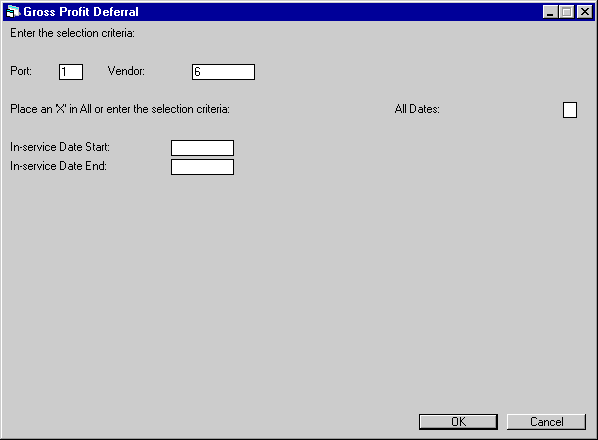
- ALL DATES
Enter X to report on all assets on file, regardless of the asset's in-service date. Leave blank if an IN-SERVICE DATE START and/or IN-SERVICE DATE END are entered.
- IN-SERVICE
DATE START
Enter the beginning in-service date in MM/DD/YY format. The date must be on or before today's date. All assets with an in-service date on or after this date are selected. If both an IN-SERVICE DATE START and IN-SERVICE DATE END are entered, all assets with an in-service date on or between these dates are selected. Leave IN-SERVICE DATE START blank if all assets are desired or if all assets with an in-service date before the IN-SERVICE DATE END are desired.
- IN-SERVICE
DATE END
Enter the ending in-service date in MM/DD/YY format. The date must be on or before today's date. All assets with an in-service date on or before this date are selected. If both an IN-SERVICE DATE START and an IN-SERVICE DATE END are entered, all assets with an in-service date on or between these dates are selected. Leave IN-SERVICE DATE END blank if all assets are desired or if all assets with an in-service date on or after the IN-SERVICE DATE START date are desired.
Gross Profit Deferral Report

The Gross Profit Deferral report [U0608A] reports at the asset level and provides the following information:
- LEASE
- ASSET
- ASSET DESCRIPTION
The asset description is displayed.
- IN-SERV
DATE
The in-service date of the asset is displayed.
- ORIGINAL
GROSS PROFIT
The original amount of deferred gross profit is displayed. Gross profit on sales type leases is taxed over the life of the lease, rather than at its inception. It is calculated as follows:ORIGINAL ASSET COST - MANUFACTURER'S TAX BASIS
- BEGINNING
BALANCE
The amount of gross profit not yet restored at the start of the year is displayed.
- CURRENT GROSS PROFIT
RESTORED - EXISTING
The amount of deferred gross profit which has been restored is displayed -- the asset is retained by the lessor.
- CURRENT
GROSS PROFIT RESTORED - UNRELATED
The amount of deferred gross profit which has been restored is displayed -- the asset was sold to an unrelated third party.
- CURRENT
GROSS PROFIT RESTORED - RELATED
The amount of deferred gross profit which has been restored is displayed -- the asset was sold to a related third party.
- ENDING
BALANCE
The amount of deferred gross profit remaining to be taken is displayed. It is calculated as follows:BEGINNING BALANCE
- CURRENT GROSS PROFIT RESTORED EXISTING
- CURRENT GROSS PROFIT RESTORED UNRELATED
- CURRENT GROSS PROFIT RESTORED RELATEDDollar amounts are totaled for leases. Page totals appear for number of leases and all dollar amounts are shown by vendor.
Tax Benefit Repayment Report

The Tax Benefit Repayment report [U0608B] reports at the asset level and provides the following information:
- LEASE
- ASSET
- ASSET DESCRIPTION
The asset description is displayed.
- IN-SERV
DATE
The in-service date of the asset is displayed.
- ORIGINAL
TAX BENEFIT
The original amount of tax benefit (interest-free loan) is displayed. It is calculated as follows:ORIGINAL GROSS PROFIT
* PORTFOLIO TAX RATE - BEGINNING
BALANCE
The balance of unrepaid tax benefit at the start of the year is displayed.
- CURRENT
TAX BENEFIT RESTORED - EXISTING
The amount of tax benefit to repay is displayed -- the asset is retained by the lessor.
- CURRENT
TAX BENEFIT RESTORED - UNRELATED
The amount of tax benefit to repay is displayed -- the asset was sold to an unrelated third party.
- CURRENT
TAX BENEFIT RESTORED - RELATED
The amount of tax benefit to repay is displayed -- the asset was sold to a related third party.
- ENDING
BALANCE
The amount of tax benefit unrepaid is displayed. It is calculated as follows:(BEGINNING BALANCE
- CURRENT TAX BENEFIT RESTORED EXISTING
- CURRENT TAX BENEFIT RESTORED UNRELATED
- CURRENT TAX BENEFIT RESTORED RELATED)
* PORTFOLIO TAX RATEDollar amounts are totaled for leases and page totals for number of leases and all dollar amounts are shown by vendor.
LeasePak Documentation Suite
©
by NetSol Technologies Inc. All rights reserved.
The information contained in this document is the property of NetSol Technologies Inc. Use of the information contained herein is restricted. Conditions of use are subject to change without notice. NetSol Technologies Inc. assumes no liability for any inaccuracy that may appear in this document; the contents of this document do not constitute a promise or warranty. The software described in this document is furnished under license and may be used or copied only in accordance with the terms of said license. Unauthorized use, alteration, or reproduction of this document without the written consent of NetSol Technologies Inc. is prohibited.